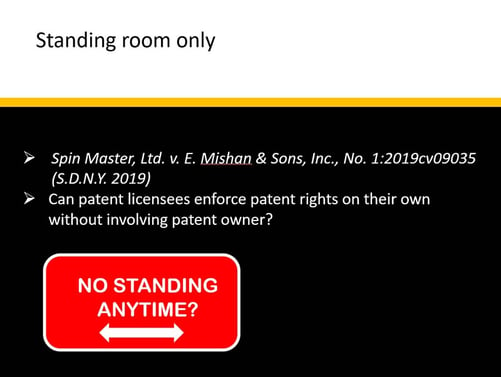Spin Master, Ltd. v. E. Mishan & Sons, Inc., No. 1:2019cv09035 (S.D.N.Y. 2019)
Does a licensee have standing to bring an infringement action against an accused infringer, or does the patent owner have to be involved somehow?
 The provisions of 35 USC 281 only allow a “patentee” to bring a civil action for patent infringement. In some fact-dependent scenarios, a licensee who has “all substantial rights” under a patent qualifies as a patentee for purposes of Section 281. A “mere licensee” without all substantial rights is not a patentee. Hence, it almost always would be the case that a nonexclusive licensee lacks standing to bring a patent infringement action. Note that there has been at least one case in the area of the common interest doctrine where a nonexclusive licensee was deemed to be an exclusive licensee with sufficient rights to support protecting privilege for communications exchanged between licensor and licensee. It is conceivable that such a “de facto” exclusive licensee could be a patentee under Section 281. It remains to be seen whether a wider range of parties might have standing to bring “non-civil” patent infringement actions, such as by acting as a private attorney general.
The provisions of 35 USC 281 only allow a “patentee” to bring a civil action for patent infringement. In some fact-dependent scenarios, a licensee who has “all substantial rights” under a patent qualifies as a patentee for purposes of Section 281. A “mere licensee” without all substantial rights is not a patentee. Hence, it almost always would be the case that a nonexclusive licensee lacks standing to bring a patent infringement action. Note that there has been at least one case in the area of the common interest doctrine where a nonexclusive licensee was deemed to be an exclusive licensee with sufficient rights to support protecting privilege for communications exchanged between licensor and licensee. It is conceivable that such a “de facto” exclusive licensee could be a patentee under Section 281. It remains to be seen whether a wider range of parties might have standing to bring “non-civil” patent infringement actions, such as by acting as a private attorney general.
It is possible, but not a given, that an exclusive licensee qualifies as a patentee and has standing under Section 281 to bring a civil action for patent infringement. For example, the exclusive licensee in this case brought an infringement action against an accused infringer without involving the patent owner. The accused infringer argued that the exclusive license was not a patentee and, therefore, did not have standing to bring the action. The accused infringer requested that the court throw the action to the curb.
The exclusive licensee, though, held an exclusive license without any field restrictions. The licensee had the power to sublicense. The licensee had the exclusive right to sue infringers with full control over any litigation. The district court from the Southern District of New York ruled that this exclusive licensee had all substantial rights under the asserted patent rights and, therefore, had standing as a patentee under Section 281. The litigation could proceed with the licensee as plaintiff. The patent owner was not a necessary party.
License parties do have the ability to avoid standing issues. The parties can use contract language that allocates litigation control to the licensee while obligating the patent owner to be named as a party to support standing. Even nonexclusive licensees can fight infringement battles in these circumstances.

